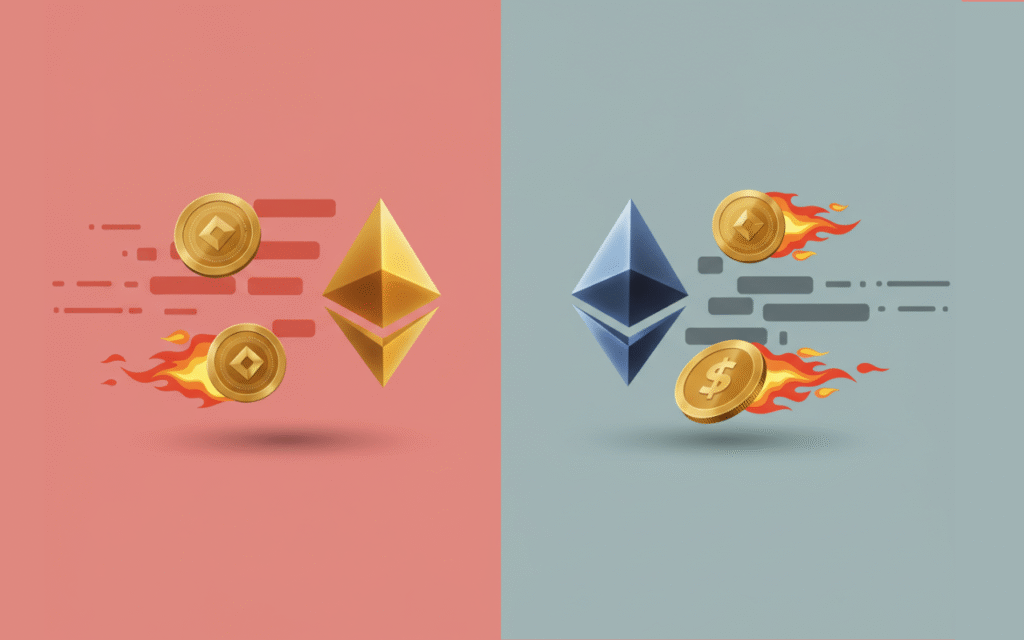If you’ve spent any time exploring the world of Ethereum, you’ve likely come across the term “gas wars”. While it might sound like something out of a sci-fi movie, gas wars are a very real phenomenon in the blockchain space. But what exactly are they, and why do they matter? Let’s break it down in simple terms.

What is Gas on Ethereum?
Before diving into gas wars, let’s first understand what “gas” means in the context of Ethereum. Gas is essentially the fee you pay to execute transactions or smart contracts on the Ethereum network. Think of it as the fuel that powers the Ethereum blockchain.
Every action on Ethereum, whether it’s sending ETH, minting an NFT, or interacting with a decentralized application (dApp) requires computational resources. Gas fees compensate miners (or validators in Ethereum’s proof-of-stake system) for using their resources to process your transaction.
Gas prices are measured in gwei, which is a small fraction of ETH. For example, 1 gwei equals 0.000000001 ETH. The higher the gas price you’re willing to pay, the faster your transaction is likely to be processed.
What are Gas Wars?
Now that we’ve covered gas, let’s talk about gas wars. A gas war occurs when multiple users compete to have their transactions processed as quickly as possible by offering higher gas fees. This competition drives up gas prices across the network.
→ Gas wars typically happen during highly anticipated events on Ethereum, such as:
- NFT drops: When a popular NFT collection launches, thousands of users may rush to mint tokens at the same time.
- Token sales: Initial coin offerings (ICOs) or token launches often attract heavy demand.
- DeFi opportunities: Yield farming or liquidity pool launches can create a frenzy as users try to secure high returns.
In these scenarios, the limited block space on Ethereum becomes a valuable resource. Since only a certain number of transactions can fit into each block, users start bidding against each other by increasing their gas fees, hoping miners will prioritize their transactions.
How Do Gas Wars Impact Users?
→ Gas wars can have both frustrating and expensive consequences for Ethereum users. Here’s how:
- Skyrocketing Fees: During a gas war, fees can become exorbitant. What might normally cost a few dollars in gas can suddenly jump to hundreds or even thousands of dollars for a single transaction.
- Failed Transactions: If you set a gas fee that’s too low during a gas war, your transaction may get stuck in the mempool (a sort of waiting area for unprocessed transactions). If it’s not processed in time, it could fail entirely, and you might still lose the gas you initially paid.
- Exclusion of Smaller Users: High gas prices can price out smaller users who can’t afford to compete with wealthier participants. This creates an uneven playing field and limits access to certain opportunities on Ethereum.
- FOMO and Stress: Gas wars often coincide with time-sensitive events, where missing out could mean losing a valuable opportunity. This creates a sense of urgency and stress for participants.
Why Do Gas Wars Happen?
Gas wars are essentially a supply and demand issue. When demand for Ethereum’s block space exceeds supply, competition naturally arises. Here are some key factors that contribute to gas wars:
- Limited Block Space: Ethereum blocks have a maximum size, which limits how many transactions can be included in each block. This scarcity is what drives competition during high-demand periods.
- Popular Events: Certain events like hyped NFT launches or DeFi opportunities create massive spikes in demand as thousands of users try to interact with the blockchain simultaneously.
- Speculation: Many participants in gas wars are speculators hoping to flip NFTs or tokens for profit. This speculative behavior fuels even more competition.
- Bots: Automated bots programmed to execute transactions at lightning speed can further intensify gas wars, often outpacing human users.
Can Gas Wars Be Avoided?
While gas wars are a natural byproduct of Ethereum’s design and popularity, there are ways to minimize their impact or avoid them altogether:
- Plan Ahead: If you know an event is likely to trigger a gas war, try to participate during off-peak times or set your transaction parameters carefully.
- Use Layer 2 Solutions: Layer 2 scaling solutions like Arbitrum, Optimism, and zkSync offer cheaper and faster transactions by processing them off-chain and settling them on Ethereum later. These solutions can help you avoid high gas fees during congested periods.
- Be Patient: If you’re not in a rush, consider waiting until network congestion subsides before executing your transaction.
- Set Gas Limits Wisely: When participating in an event prone to gas wars, set a realistic gas limit that balances cost and speed. Tools like Etherscan’s Gas Tracker can help you monitor current gas prices and adjust accordingly.
- Explore Other Blockchains: If high gas fees are a recurring issue for you, consider exploring alternative blockchains like Solana, Binance Smart Chain, or Polygon. While they have their own trade-offs, they often offer lower transaction costs.
How is Ethereum Addressing Gas Wars?
The Ethereum community is well aware of the challenges posed by gas wars and high fees. Several initiatives aim to address these issues:
- Ethereum 2.0 (The Merge): In September 2022, Ethereum transitioned from proof-of-work (PoW) to proof-of-stake (PoS). While this upgrade didn’t directly reduce gas fees, it laid the foundation for future scalability improvements.
- Sharding: Sharding is a planned upgrade that will split the Ethereum network into smaller pieces (or “shards”), allowing it to process more transactions simultaneously and reduce congestion.
- EIP-1559: Introduced in August 2021, this upgrade changed how gas fees work by introducing a base fee that is burned (removed from circulation). While it didn’t eliminate gas wars, it made fees more predictable and reduced volatility.
- Layer 2 Scaling: As mentioned earlier, layer 2 solutions are already helping alleviate congestion on the main Ethereum network by offloading transactions to secondary layers.
Conclusion
Gas wars may sound intimidating at first, but understanding how they work can help you navigate them with confidence. They’re a natural outcome of Ethereum’s popularity and limited block space, but they’re also a reminder of why scalability improvements are so crucial for the network’s future.
Whether you’re minting NFTs, trading tokens, or exploring DeFi, being mindful of gas fees and planning ahead can save you time, money, and frustration. And with ongoing upgrades like sharding and layer 2 solutions, there’s hope that gas wars will become less frequent over time.


